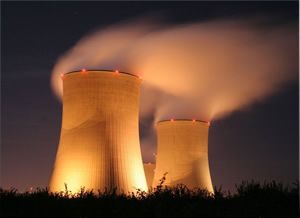
Publisher:
Bonnie King
CONTACT:
Newsroom@Salem-news.com
Advertising:
Adsales@Salem-news.com

~Truth~
~Justice~
~Peace~
TJP
Mar-29-2012 16:08

 TweetFollow @OregonNews
TweetFollow @OregonNews
No End in Sight to Rising Nuclear Power Costs?
Report: Safety Problems to Keep Nuclear Power Unaffordable
Salem-News.com
Analysis of 251 nuclear reactors finds that intractable safety issues have steadily escalated.
 Courtesy: leftfootforward.org |
(WASHINGTON DC) - Are affordable new nuclear power and safe nuclear power fundamentally incompatible?
The high cost of addressing nuclear power safety concerns that are steadily multiplying in number is now the Number 1 factor guiding new nuclear reactor construction decisions, as well as the plans for retiring old reactors in the U.S., according to a new paper presented this week by leading analyst Mark Cooper at the Symposium on the Future of Nuclear Power hosted by the Dick Thornburgh Forum for Law and Public Policy of the University of Pittsburgh.
Cooper, the senior fellow for economic analysis at the Institute for Energy and the Environment of the Vermont Law School, and author of “Policy Challenges of Nuclear Reactor Construction, Cost Escalation and Crowding Out Alternatives” (2009), analyzed a full set of data on 251 U.S. nuclear reactors planned or docketed at the Nuclear Regulatory Commission. Two dozen variables influencing the three key junctures in the development of nuclear reactors -- the build/cancel decision, construction costs and repair/retire decisions – were examined by Cooper.
Cooper also compared the historical evidence on the state of U.S. nuclear safety from the early years of the industry (up to and including the accident at Three Mile Island) to the ongoing reviews of the catastrophe at Fukushima conducted by the U.S., Japan, and major European nuclear nations.
Cooper’s conclusion: The cost of new nuclear reactors in the United States has risen steadily and will continue to do so since the industry cannot escape steadily growing safety concerns that seem to be inseparable from the technology itself.
Commenting on his paper, Cooper said: “I find that nuclear construction is not only unaffordable now, but it is very likely to become even more cost prohibitive, due to unresolved safety issues that history shows are part and parcel of reactor technology itself. Consider the facts: If we use a market standard, nuclear power is neither affordable nor worth the risk. If the owners and operators of nuclear reactors had to face the full liability of a Fukushima-style nuclear accident or go head-to-head with alternatives in a truly competitive marketplace unfettered by subsidies, no one would have built a nuclear reactor in the past, no one would build one today, and anyone who owns a reactor would exit the nuclear business as quickly as possible. The combination of a catastrophically dangerous resource, a complex technology, human frailties, and the uncertainties of natural events make it extremely unlikely that the negative answer as to the feasibility of affordable cheap nuclear energy can be changed to a positive.”
Noting the widespread extent of safety issues at U.S. reactors, the Cooper paper concludes: “In the United States more than 80 percent of US reactors face one or more of the issues that have been highlighted by the Fukushima accident – seismic risk, fire hazard, and elevated spent fuel. Moreover, half of those that do not exhibit one of these issues had a ‘near miss’ in 2011. Clearly, safety remains a challenge in the United States, one that has been magnified by Fukushima.”
In addition to safety concerns, Cooper found that the industry has for a second time failed to be able to compete with less expensive (and safer) alternatives: “In the 1970s and 1980s the nuclear industry could not overcome the problem of escalating costs and lower cost alternatives. It continues to be afflicted by the same problems. The ‘nuclear renaissance,’ which was loudly heralded with extremely optimistic cost projections proved to be a re-run of the collapse of the ‘Great Bandwagon Market’ of the 1970s and 1980s. The industry could not live up to the hype and cost projections escalated rapidly. The estimates now used by utilities are three times the initial ’renaissance’ estimates, while independent analysts on Wall Street, put the cost estimates at five times the original estimates.”
Explaining how the nuclear power industry is caught in a safety web of its creating, Cooper said: “Acquisition of new nuclear reactors embodies long-term commitments in exactly the wrong way for the current decision making environment. It commits to assets that have high risk or create large exposure to uncertainty with technologies that have vague long-term prospects (unstable resource availability and poorly understood environmental impacts). Unfortunately, admitting what you do not know is not something that the builders and operators of nuclear reactors are inclined to do. Their reaction is to insist their reactors are safe and commit to making them safer, but then complain bitterly about and fight additional safety measures that inevitably increase their already high costs.”
For the full text of the Cooper paper, go to http://www.vermontlaw.edu/
Source: Hastings Group
 |
 |
 |
 |
 |
 |
Articles for March 28, 2012 | Articles for March 29, 2012 | Articles for March 30, 2012
Quick Links
DINING
Willamette UniversityGoudy Commons Cafe
Dine on the Queen
Willamette Queen Sternwheeler
MUST SEE SALEM
Oregon Capitol ToursCapitol History Gateway
Willamette River Ride
Willamette Queen Sternwheeler
Historic Home Tours:
Deepwood Museum
The Bush House
Gaiety Hollow Garden
AUCTIONS - APPRAISALS
Auction Masters & AppraisalsCONSTRUCTION SERVICES
Roofing and ContractingSheridan, Ore.
ONLINE SHOPPING
Special Occasion DressesAdvertise with Salem-News
Contact:AdSales@Salem-News.com

googlec507860f6901db00.html



Terms of Service | Privacy Policy
All comments and messages are approved by people and self promotional links or unacceptable comments are denied.
[Return to Top]
©2025 Salem-News.com. All opinions expressed in this article are those of the author and do not necessarily reflect those of Salem-News.com.